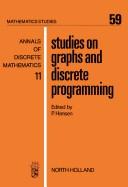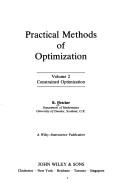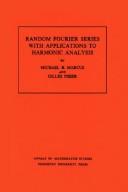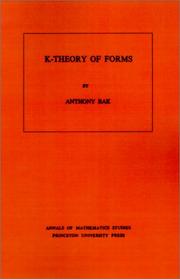| Listing 1 - 8 of 8 |
Sort by
|

ISBN: 0444862161 9780444862167 9780080871707 0080871704 1281797332 9781281797339 9786611797331 Year: 1981 Volume: 11 59 Publisher: Amsterdam ; New York : North-Holland,
Abstract | Keywords | Export | Availability | Bookmark
 Loading...
Loading...Choose an application
- Reference Manager
- EndNote
- RefWorks (Direct export to RefWorks)
Studies on Graphs and Discrete Programming
Discrete mathematics --- Network analysis (Planning) --- Graph theory --- Integer programming --- Théorie des graphes --- Programmation en nombres entiers --- Congresses. --- Congresses --- Congrès --- ELSEVIER-B EPUB-LIV-FT --- Network analysis (planning) --- Programming (Mathematics) --- Project networks --- Planning --- System analysis --- Network analysis (planning) - Congresses --- Graph theory - Congresses --- Integer programming - Congresses
Book
ISBN: 3704500062 9783704500069 Year: 1981 Publisher: Laxenburg: International institute for applied systems analysis,
Abstract | Keywords | Export | Availability | Bookmark
 Loading...
Loading...Choose an application
- Reference Manager
- EndNote
- RefWorks (Direct export to RefWorks)
#TCPW T2.2 --- 519.6 --- 681.3*G16 --- Computational mathematics. Numerical analysis. Computer programming --- Optimization: constrained optimization; gradient methods; integer programming; least squares methods; linear programming; nonlinear programming (Numericalanalysis) --- 681.3*G16 Optimization: constrained optimization; gradient methods; integer programming; least squares methods; linear programming; nonlinear programming (Numericalanalysis) --- 519.6 Computational mathematics. Numerical analysis. Computer programming --- Linear programming --- Linear programming. --- Mathematical models --- Mathematical models.

ISBN: 0471278289 9780471278283 Year: 1981 Publisher: Chichester: Wiley,
Abstract | Keywords | Export | Availability | Bookmark
 Loading...
Loading...Choose an application
- Reference Manager
- EndNote
- RefWorks (Direct export to RefWorks)
Mathematical optimization --- Optimization (Mathematics) --- Optimization techniques --- Optimization theory --- Systems optimization --- Mathematical analysis --- Maxima and minima --- Operations research --- Simulation methods --- System analysis --- Optimization: constrained optimization gradient methods integer programming least squares methods linear programming nonlinear programming (Numericalanalysis) --- 681.3*G16 Optimization: constrained optimization gradient methods integer programming least squares methods linear programming nonlinear programming (Numericalanalysis) --- 519.8 --- 519.6 --- 681.3*G16 --- 681.3*G16 Optimization: constrained optimization; gradient methods; integer programming; least squares methods; linear programming; nonlinear programming (Numericalanalysis) --- Optimization: constrained optimization; gradient methods; integer programming; least squares methods; linear programming; nonlinear programming (Numericalanalysis) --- 519.6 Computational mathematics. Numerical analysis. Computer programming --- Computational mathematics. Numerical analysis. Computer programming --- 519.8 Operational research --- Operational research --- Mathematical optimization. --- Programming (Mathematics) --- Programmation (mathématiques) --- Programmation (mathématiques)
Book
ISBN: 3540105611 3642483208 Year: 1981 Publisher: Berlin Springer
Abstract | Keywords | Export | Availability | Bookmark
 Loading...
Loading...Choose an application
- Reference Manager
- EndNote
- RefWorks (Direct export to RefWorks)
................................................................. The performance of a nonlinear programming algorithm can only be ascertained by numerical experiments requiring the collection and implementation of test examples in dependence upon the desired performance criterium. This book should be considered as an assis tance for a test designer since it presents an extensive collec tion of nonlinear programming problems which have been used in the past to test or compare optimization programs. He will be in formed about the optimal solution, about the structure of the problem in the neighbourhood of the solution, and, in addition, about the usage of the corresp,onding FORTRAN subroutines if he is interested in obtaining them -ofi a magnetic tape. Chapter I shows how the test examples are documented. In par ticular, the evaluation of computable information about the solu tion of a problem is outlined. It is explained how the optimal solution, the optimal Lagrange-multipliers, and the condition number of the projected Hessian of the Lagrangian are obtained. Furthermore, a classification number is defined allowing a formal description of a test problem, and the documentation scheme is described which is used in Chapter IV to present the problems.
Planning (firm) --- Operational research. Game theory --- 519.85 --- 517.988 --- 681.3*G16 --- Mathematical programming --- Nonlinear functional analysis and approximation methods --- Optimization: constrained optimization; gradient methods; integer programming; least squares methods; linear programming; nonlinear programming (Numericalanalysis) --- Management --- Business & Economics --- Management Theory --- 681.3*G16 Optimization: constrained optimization; gradient methods; integer programming; least squares methods; linear programming; nonlinear programming (Numericalanalysis) --- 517.988 Nonlinear functional analysis and approximation methods --- 519.85 Mathematical programming
Book
ISBN: 0471099880 9780471099888 Year: 1981 Publisher: Chichester: New York: Wiley,
Abstract | Keywords | Export | Availability | Bookmark
 Loading...
Loading...Choose an application
- Reference Manager
- EndNote
- RefWorks (Direct export to RefWorks)
Computer architecture. Operating systems --- Mathematical optimization --- Numerical analysis --- Computer simulation --- Data processing --- -Numerical analysis --- -Computer simulation --- #TCPW N3.0 --- 519.6 --- 681.3*G16 --- Computer modeling --- Computer models --- Modeling, Computer --- Models, Computer --- Simulation, Computer --- Electromechanical analogies --- Mathematical models --- Simulation methods --- Model-integrated computing --- Mathematical analysis --- Optimization (Mathematics) --- Optimization techniques --- Optimization theory --- Systems optimization --- Maxima and minima --- Operations research --- System analysis --- Computational mathematics. Numerical analysis. Computer programming --- Optimization: constrained optimization; gradient methods; integer programming; least squares methods; linear programming; nonlinear programming (Numericalanalysis) --- 681.3*G16 Optimization: constrained optimization; gradient methods; integer programming; least squares methods; linear programming; nonlinear programming (Numericalanalysis) --- 519.6 Computational mathematics. Numerical analysis. Computer programming --- Mathematical optimization - Data processing --- Numerical analysis - Data processing

ISBN: 0691082898 0691082928 1400881536 Year: 1981 Volume: no. 101 Publisher: Princeton (N.J.) : Princeton university press,
Abstract | Keywords | Export | Availability | Bookmark
 Loading...
Loading...Choose an application
- Reference Manager
- EndNote
- RefWorks (Direct export to RefWorks)
In this book the authors give the first necessary and sufficient conditions for the uniform convergence a.s. of random Fourier series on locally compact Abelian groups and on compact non-Abelian groups. They also obtain many related results. For example, whenever a random Fourier series converges uniformly a.s. it also satisfies the central limit theorem. The methods developed are used to study some questions in harmonic analysis that are not intrinsically random. For example, a new characterization of Sidon sets is derived.The major results depend heavily on the Dudley-Fernique necessary and sufficient condition for the continuity of stationary Gaussian processes and on recent work on sums of independent Banach space valued random variables. It is noteworthy that the proofs for the Abelian case immediately extend to the non-Abelian case once the proper definition of random Fourier series is made. In doing this the authors obtain new results on sums of independent random matrices with elements in a Banach space. The final chapter of the book suggests several directions for further research.
Harmonic analysis. Fourier analysis --- Fourier series. --- Harmonic analysis. --- Fourier, Séries de --- Analyse harmonique --- 517.518.4 --- Fourier series --- Harmonic analysis --- Analysis (Mathematics) --- Functions, Potential --- Potential functions --- Banach algebras --- Calculus --- Mathematical analysis --- Mathematics --- Bessel functions --- Harmonic functions --- Time-series analysis --- Fourier integrals --- Series, Fourier --- Series, Trigonometric --- Trigonometric series --- Fourier analysis --- 517.518.4 Trigonometric series --- Fourier, Séries de --- Abelian group. --- Almost periodic function. --- Almost surely. --- Banach space. --- Big O notation. --- Cardinality. --- Central limit theorem. --- Circle group. --- Coefficient. --- Commutative property. --- Compact group. --- Compact space. --- Complex number. --- Continuous function. --- Corollary. --- Discrete group. --- Equivalence class. --- Existential quantification. --- Finite group. --- Gaussian process. --- Haar measure. --- Independence (probability theory). --- Inequality (mathematics). --- Integer. --- Irreducible representation. --- Non-abelian group. --- Non-abelian. --- Normal distribution. --- Orthogonal group. --- Orthogonal matrix. --- Probability distribution. --- Probability measure. --- Probability space. --- Probability. --- Random function. --- Random matrix. --- Random variable. --- Rate of convergence. --- Real number. --- Ring (mathematics). --- Scientific notation. --- Set (mathematics). --- Slepian's lemma. --- Small number. --- Smoothness. --- Stationary process. --- Subgroup. --- Subset. --- Summation. --- Theorem. --- Uniform convergence. --- Unitary matrix. --- Variance.

ISBN: 069108274X 0691082758 1400881412 9780691082752 9780691082745 Year: 1981 Volume: 98 Publisher: Princeton (N.J.): Princeton university press,
Abstract | Keywords | Export | Availability | Bookmark
 Loading...
Loading...Choose an application
- Reference Manager
- EndNote
- RefWorks (Direct export to RefWorks)
The description for this book, K-Theory of Forms. (AM-98), Volume 98, will be forthcoming.
Category theory. Homological algebra --- 515.14 --- Algebraic topology --- 515.14 Algebraic topology --- Forms (Mathematics) --- K-theory --- Modules (Algebra) --- Finite number systems --- Modular systems (Algebra) --- Algebra --- Finite groups --- Rings (Algebra) --- Homology theory --- Quantics --- Mathematics --- K-theory. --- Abelian group. --- Addition. --- Algebraic K-theory. --- Algebraic topology. --- Approximation. --- Arithmetic. --- Canonical map. --- Coefficient. --- Cokernel. --- Computation. --- Coprime integers. --- Coset. --- Direct limit. --- Direct product. --- Division ring. --- Elementary matrix. --- Exact sequence. --- Finite group. --- Finite ring. --- Free module. --- Functor. --- General linear group. --- Global field. --- Group homomorphism. --- Group ring. --- Homology (mathematics). --- Integer. --- Invertible matrix. --- Isomorphism class. --- Linear map. --- Local field. --- Matrix group. --- Maxima and minima. --- Mayer–Vietoris sequence. --- Module (mathematics). --- Monoid. --- Morphism. --- Natural transformation. --- Normal subgroup. --- P-group. --- Parameter. --- Power of two. --- Product category. --- Projective module. --- Quadratic form. --- Requirement. --- Ring of integers. --- Semisimple algebra. --- Sesquilinear form. --- Special case. --- Steinberg group (K-theory). --- Steinberg group. --- Subcategory. --- Subgroup. --- Subspace topology. --- Surjective function. --- Theorem. --- Theory. --- Topological group. --- Topological ring. --- Topology. --- Torsion subgroup. --- Triviality (mathematics). --- Unification (computer science). --- Unitary group. --- Witt group. --- K-théorie

ISBN: 0691082847 0691082790 1400881447 9780691082844 Year: 1981 Volume: 99 Publisher: Princeton (N.J.): Princeton university press,
Abstract | Keywords | Export | Availability | Bookmark
 Loading...
Loading...Choose an application
- Reference Manager
- EndNote
- RefWorks (Direct export to RefWorks)
The theory of Toeplitz operators has come to resemble more and more in recent years the classical theory of pseudodifferential operators. For instance, Toeplitz operators possess a symbolic calculus analogous to the usual symbolic calculus, and by symbolic means one can construct parametrices for Toeplitz operators and create new Toeplitz operators out of old ones by functional operations.If P is a self-adjoint pseudodifferential operator on a compact manifold with an elliptic symbol that is of order greater than zero, then it has a discrete spectrum. Also, it is well known that the asymptotic behavior of its eigenvalues is closely related to the behavior of the bicharacteristic flow generated by its symbol.It is natural to ask if similar results are true for Toeplitz operators. In the course of answering this question, the authors explore in depth the analogies between Toeplitz operators and pseudodifferential operators and show that both can be viewed as the "quantized" objects associated with functions on compact contact manifolds.
Operator theory --- Toeplitz operators --- Spectral theory (Mathematics) --- 517.984 --- Spectral theory of linear operators --- Toeplitz operators. --- Spectral theory (Mathematics). --- 517.984 Spectral theory of linear operators --- Operators, Toeplitz --- Linear operators --- Functional analysis --- Hilbert space --- Measure theory --- Transformations (Mathematics) --- Algebraic variety. --- Asymptotic analysis. --- Asymptotic expansion. --- Big O notation. --- Boundary value problem. --- Change of variables. --- Chern class. --- Codimension. --- Cohomology. --- Compact group. --- Complex manifold. --- Complex vector bundle. --- Connection form. --- Contact geometry. --- Corollary. --- Cotangent bundle. --- Curvature form. --- Diffeomorphism. --- Differentiable manifold. --- Dimensional analysis. --- Discrete spectrum. --- Eigenvalues and eigenvectors. --- Elaboration. --- Elliptic operator. --- Embedding. --- Equivalence class. --- Existential quantification. --- Exterior (topology). --- Fourier integral operator. --- Fourier transform. --- Hamiltonian vector field. --- Holomorphic function. --- Homogeneous function. --- Hypoelliptic operator. --- Integer. --- Integral curve. --- Integral transform. --- Invariant subspace. --- Lagrangian (field theory). --- Lagrangian. --- Limit point. --- Line bundle. --- Linear map. --- Mathematics. --- Metaplectic group. --- Natural number. --- Normal space. --- One-form. --- Open set. --- Operator (physics). --- Oscillatory integral. --- Parallel transport. --- Parameter. --- Parametrix. --- Periodic function. --- Polynomial. --- Projection (linear algebra). --- Projective variety. --- Pseudo-differential operator. --- Q.E.D. --- Quadratic form. --- Quantity. --- Quotient ring. --- Real number. --- Scientific notation. --- Self-adjoint. --- Smoothness. --- Spectral theorem. --- Spectral theory. --- Square root. --- Submanifold. --- Summation. --- Support (mathematics). --- Symplectic geometry. --- Symplectic group. --- Symplectic manifold. --- Symplectic vector space. --- Tangent space. --- Theorem. --- Todd class. --- Toeplitz algebra. --- Toeplitz matrix. --- Toeplitz operator. --- Trace formula. --- Transversal (geometry). --- Trigonometric functions. --- Variable (mathematics). --- Vector bundle. --- Vector field. --- Vector space. --- Volume form. --- Wave front set. --- Opérateurs pseudo-différentiels
| Listing 1 - 8 of 8 |
Sort by
|

 Search
Search Feedback
Feedback About UniCat
About UniCat  Help
Help News
News